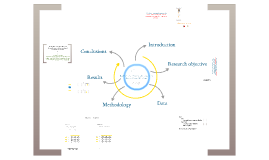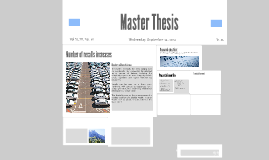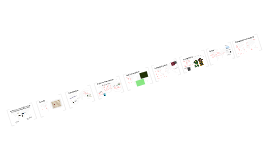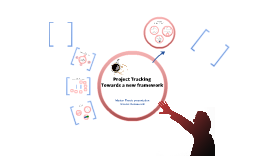master thesis presentation
Transcript: The Problem Soaring power demand loads -> Electric utilities design capacities according to peak loads -> .... this necessitates capital intensive investments ... and often leads to having under-utilized systems... Solution...?! Control our demand! -> Demand Side Management Research Objectives?! Propose a Smart Grid environment for the MENA Region (PLC, NCS) Develop a Load Management algorithm for the Residential Sector (DSM) Add modifications to the electricity billing system Energy Situation @MENA Residential Sector! 40-65% ~ Algeria, UAE, KSA, Egypt, Jordan, Syria Demand Side Management DSM @MENA?! Mostly Energy Efficiency projects Very limited initiatives in Demand Response (mainly in the industrial sector) No Load Management practices! Wet Appliances 1 Washing Machine 1 Dryer 1 Dish Washer Brown Appliances 1 Laptop 1 Desktop Computer 2 TV 2 CFL Lighting (10 W) 2 CFL Lighting (15 W) 3 CFL Lighting (20 W) 1 Game Console 1 Radio Cold/Hot Appliances 1 Refrigerator 1 Freezer 1 Water Heater 1 Water Cooler 4 Air Conditioner Cooking Appliances 1 Coffee Maker 1 Microwave 1 Electric Stove Algorithm?! Smart Grid! Characteristics?! Integration of electricity sector stakeholders Advanced Metering Infrastructure (AMI) Advanced system monitoring and control Substation and distribution automation Integration of energy storage and electric vehicles Integration of distributed generation capacities Advanced interfaces and decision support tools. Benefits?! More efficient electricity generation, transmission, and distribution Quicker electricity restoration after power interruptions Reduced peak demand Reduced management, operations and maintenance costs for utilities Lower power costs for consumers Increased integration of distributed renewable energy generation capacities Improved security, reliability, flexibility, quality of service, and robustness Power Line Communication PLC operates by sending data over power lines... Data signals modulate a radio frequency carrier signal which is then sent over power wiring Advantages of PLC @MENA Extensive coverage in the MENA Region (access of electricity exceeds 90% in most countries of the region) Needed PLC extensions can be established quickly and in a cost effective way Offers multiple services via the same infrastructure (e.g. Load Management, and Advanced Metering Infrastructure) Networked Control Systems Intelligent control device + Transceiver = Smart Transceiver Such solutions offer... Modularity Easy installation Great flexibility and reliability Short time to market development Replace central control and automation systems which are no longer sufficient for large complex smart grid operations Socio-Economic Issues Electricity Pricing Fixed pricing (independent of time and demand load) Flat rate Piecewise linear Time differentiated pricing: Time of Use Pricing (TOU) Critical Peak Pricing (CPP) Real Time Pricing (RTP) Electricity Billing Energy Charges ($/kWh) Demand Charges ($/kW) Extra Charges (installations, taxes, garbage collection!) energy charges demand charges Family household ~ E =750 kWh, Pmax = 10 kW Demand charge is 7 L.E. for every kW of maximum power demand a month Results, Conclusions and Future Work Results Algorithm Peak minimized by more than 35% Load factor improved by more than 58% Proposed billing system modifications Proposed dynamic sizing for energy charge blocks (10 - 20%) bill savings for lower meter capacities Adding demand charges (10 -15%) bill savings after minimizing peaks Proposed outlines for a Smart Grid environment @MENA Power Line Communication Networked Control Systems Java-based Graphical User Interface Conclusions Set clearer energy strategies with strict bounding measures (focus on DSM practices) DSM programs need to be more effectively and efficiently designed and deployed, and highly promoted More customer engagement Load Management ~ creates a "virtual power plant" that generates "negawatts" instead of megawatts! Future Work Design a complete DSM program easily customizable by different electric utilities in the MENA Region Investigate other access communication technologies (wireless communication systems) Consider long term usage changes and penetration rates of appliances Study a multi-variant regression model for assessing the performance of DSM programs. Thank You! Non-flexible loads - 24 hours load profile Total electricity consumption - 24 hours load profile Access PLC Total Population > 376 Million Land Area 8,644,000 sq. km. 57% ~ proven oil reserves 41% ~ proven natural gas resources Energy use growing by a rate of 170% complete load managment system in smart grid environment Multi-variant Regression Model Internatiional Monetary Fund 2009 Types of Load Management Load Shifting Flow Chart Electricity Consumption Pattern of Different Appliances Load Shedding NIST 2012 Shiftable/flexible loads to be shifted - 24 hours load profile World Bank Development Indicators 2009 Meter Capacity vs. Energy Charge Blocks Results

















